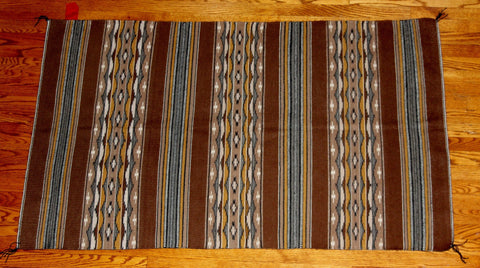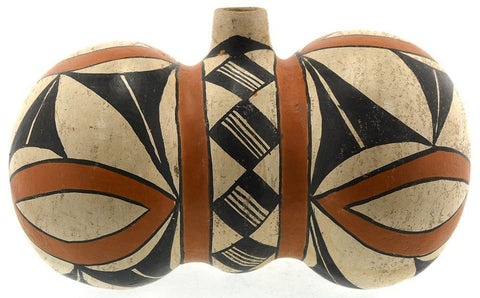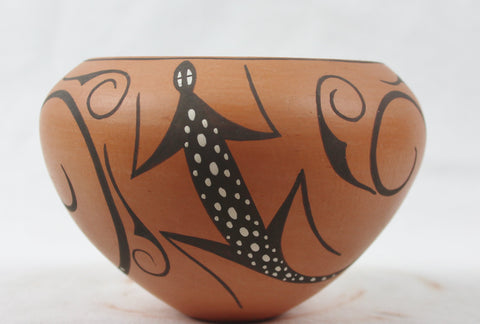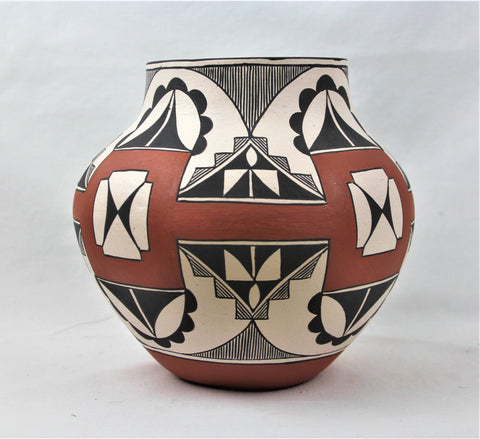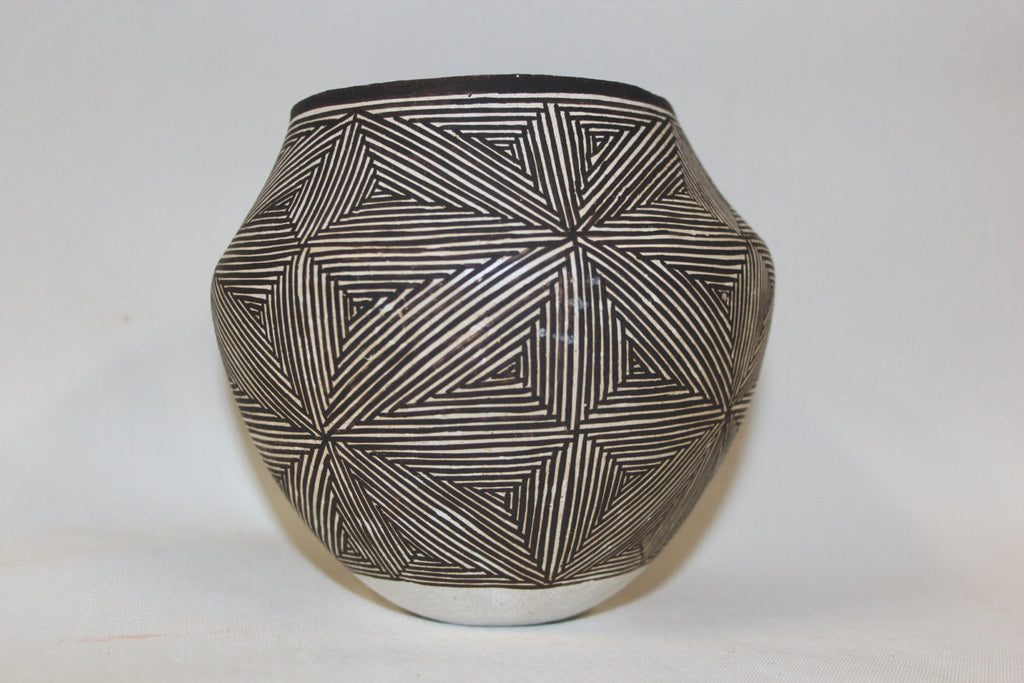
Acoma Pottery : Native American Acoma Pottery Jar, by Lucy Lewis #175-Sold to Larry
$ 1,975.00
Native American
Acoma Pottery
175. Description: 1960's- 70's fine line design with very minor pitting, signed Lucy M. Lewis with a dimension of 5"x 5.25".
"Lucy Lewis is regarded as the matriarch of Acoma pottery and alongside Maria Martinez, is one of the best known Southwestern potters. She started making pottery around the turn of the century, continuing a tradition dating back hundreds, if not thousands of years. Lucy M Lewis grew up in the Acoma pueblo, a Pueblo Indian community and the oldest continuously inhabited settlement in North America. Miss Lewis, who was a self-taught artist, won many awards, including the New Mexico Governor's Award in 1983.
She followed pueblo tradition in every step of pottery production offering prayers of thanks to Mother Earth for the clay, taking only as much clay as she needed, working the clay with only her hands, forming the vessel from coils of clay, scraping the walls with tools fashioned from gourds, painting the vessel with slips and paints made from clay and vegetal sources and, finally, firing the finished pieces in an outdoor handmade kiln.
Lucy Lewis's works have been exhibited in museums and embassies around the world, and are included in collections at the Smithsonian Institution in Washington and the Museum of the American Indian in New York.
Lucy Martin Lewis passed away on March 12, 1992 at a supposed age of 93. Her year of birth is not known. She spent nearly all her life atop the high mesa of Acoma Pueblo, making pottery since the age of 7. She is largely responsible for the revival of Mimbres black-on-white pottery designs which are more than 1,000 years old. She was famous, as well, for her exquisite poly chrome designs and her fine-line and lightning designs.
Lucy Lewis was one of the most widely respected potters from her pueblo. She was the last of the Acoma matriarchs. She followed pueblo tradition in every step of pottery production offering prayers of thanks to Mother Earth for the clay, taking only as much clay as she needed, working the clay with only her hands, forming the vessel from coils of clay, scraping the walls with tools fashioned from gourds, painting the vessel with slips and paints made from clay and vegetal sources and, finally, firing the finished pieces in an outdoor handmade kiln. Lucy signed her pottery as Lucy M. Lewis (Source Adobe Gallery).
A History of Pueblo Pottery:
“Pueblo pottery is made using a coiled technique that came into northern Arizona and New Mexico from the south, some 1500 years ago. In the four-corners region of the US, nineteen pueblos and villages have historically produced pottery. Although each of these pueblos use similar traditional methods of coiling, shaping, finishing and firing, the pottery from each is distinctive.
Various clay's gathered from each pueblo’s local sources produce pottery colors that range from buff to earthy yellows, oranges, and reds, as well as black. Fired pots are sometimes left plain and other times decorated—most frequently with paint and occasionally with appliqué. Painted designs vary from pueblo to pueblo, yet share an ancient iconography based on abstract representations of clouds, rain, feathers, birds, plants, animals and other natural world features.
Tempering materials and paints, also from natural sources, contribute further to the distinctiveness of each pueblo’s pottery. Some paints are derived from plants, others from minerals. Before firing, potters in some pueblos apply a light colored slip to their pottery, which creates a bright background for painted designs or simply a lighter color plain ware vessel. Designs are painted on before firing, traditionally with a brush fashioned from yucca fiber.
Different combinations of paint color, clay color, and slips are characteristic of different pueblos. Among them are black on cream, black on buff, black on red, dark brown and dark red on white (as found in Zuni pottery), matte red on red, and polychrome—a number of natural colors on one vessel (most typically associated with Hopi). Pueblo potters also produce undecorated polished black ware, black on black ware, and carved red and carved black wares.
Making pueblo pottery is a time-consuming effort that includes gathering and preparing the clay, building and shaping the coiled pot, gathering plants to make the colored dyes, constructing yucca brushes, and, often, making a clay slip. While some Pueblo artists fire in kilns, most still fire in the traditional way in an outside fire pit, covering their vessels with large potsherds and dried sheep dung. Pottery is left to bake for many hours, producing a high-fired result.
Today, Pueblo potters continue to honor this centuries-old tradition of hand-coiled pottery production, yet value the need for contemporary artistic expression as well. They continue to improve their style, methods and designs, often combining traditional and contemporary techniques to create striking new works of art.” (Source: Museum of Northern Arizona)
----------
View the other items in my shop: http://www.etsy.com/shop/CulturalPatina?ref=shopsection_shophome_leftnav

